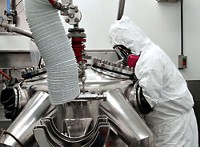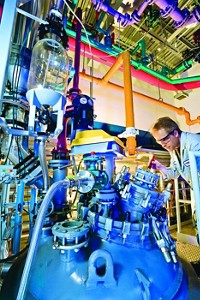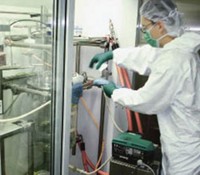Advertisement
Grab your lab coat. Let's get started
Welcome!
Welcome!
Create an account below to get 6 C&EN articles per month, receive newsletters and more - all free.
It seems this is your first time logging in online. Please enter the following information to continue.
As an ACS member you automatically get access to this site. All we need is few more details to create your reading experience.
Not you? Sign in with a different account.
Not you? Sign in with a different account.
ERROR 1
ERROR 1
ERROR 2
ERROR 2
ERROR 2
ERROR 2
ERROR 2
Password and Confirm password must match.
If you have an ACS member number, please enter it here so we can link this account to your membership. (optional)
ERROR 2
ACS values your privacy. By submitting your information, you are gaining access to C&EN and subscribing to our weekly newsletter. We use the information you provide to make your reading experience better, and we will never sell your data to third party members.
Business
Custom Chemicals
Seeing some improvement in business, contract manufacturers hope for stability during a period of continuing uncertainty
by Ann M. Thayer
January 30, 2012
| A version of this story appeared in
Volume 90, Issue 5

No one can be sure the worst is over, and that’s the problem. A rebound from the Great Recession arrived in 2010, but new economic setbacks followed in 2011. Hoping to finally put the recession behind it, the custom chemical industry sees signs that business is improving, but they aren’t clear enough to instill confidence. The slow recovery has created a “self-perpetuating hesitancy,” laments one industry executive.
“It’s a tough old world out there,” says Mark C. Griffiths, chief executive officer of Carbogen Amcis, a Swiss pharmaceutical chemical maker. “I’m not pessimistic, but it is hard work, and you have to kiss a lot of frogs, otherwise the opportunities aren’t there. Sitting back and waiting for late-phase commercial products to drop in your lap is not a winning strategy, if it ever was.”
Despite its difficulties, the contract manufacturing sector is growing. “The industry hasn’t done too badly overall,” says consultant Jan Ramakers. Estimating growth at 4–4.5% per year, Ramakers says the fine chemicals market will expand from $96 billion in sales in 2010 to about $120 billion by 2015. The market includes pharmaceuticals, aroma chemicals, and agrochemicals. By 2015, the pharmaceutical portion should be about 71% of the total, up from 67% today.
The performance of the industry’s top 40 firms shows that profitability, which had fallen during the recession, is improving as well. In 2008, 30% of the companies had an operating profit margin of more than 15%, and only 10% had a profit margin below 5%, Ramakers says. “That changed dramatically in 2009 when close to 50% of the industry had an operating profit margin below 5%, which includes a number reporting losses.”
The situation improved last year, when about 38% of the companies had an operating profit margin of 5% or less and 20% of the companies had an operating profit margin above 15%. Although companies haven’t yet reported their 2011 results, Ramakers anticipates that the year will look similar to 2010. “The big question is what is going to happen this year,” he adds.
The outlook from Eric P. Neuffer, Cambrex’ vice president of sales and business development in North America, is upbeat. “We saw a strong year in 2011 and the beginnings of a strong 2012 in areas that include highly potent compounds and controlled substances,” he says. However, while the U.S. economy has rebounded, it is not yet at precrisis strength, and economic conditions in Europe are uncertain, he points out.
“Cambrex has seen a resurgence in late-stage custom development opportunities coming from the emerging and midsized companies in North America,” Neuffer says. “But custom development business coming from Europe continues to be depressed.”
A bright spot is Scandinavia, where there are hints of growth. “This is giving us some hope that maybe Scandinavia will be the beginning of a resurgence in Europe, although I don’t think it will be as quick as what we have seen in North America,” he says.
Besides geography, size is a factor, with less business coming from large drug firms and more from smaller ones. “Many of the smaller companies have already rightsized their portfolios. They are now focused on their key late-stage products, and that is what we are getting a view of,” Neuffer explains. Meanwhile, big pharma is looking to acquire late-stage candidates.
As a result, small companies are under pressure to do more proof-of-concept work, sometimes through Phase II clinical trials, to get a good return on their best bets. “It makes sense for the smaller firms to be focusing on those programs, so that’s where our focus is,” Neuffer says. “The number of proposals coming in, as well as the quality, has dramatically improved.”
On the surface, it appears that pipeline productivity has improved. In 2011, the Food & Drug Administration approved 30 new molecular entities, compared with 21 in 2010. This milestone, however, needs to be looked at “with common sense, rather than wishful thinking,” Ramakers says, because it is likely the result of FDA catching up.
“This happened in the mid-1990s when everybody thought it was structural change in the industry and it was just clearing out of the backlog.” Nevertheless, he adds, “it’s nice to have new products come out of the pipeline and get to the commercial stage and generate some more business.”
New products are needed because the pharmaceutical industry has entered an unprecedented period of patent expirations. From the start of 2012 through 2015, drugs totaling more than $100 billion in global sales—$40 billion worth this year alone—will face generic competition, according to the market research firm IMS Health. These lost sales are expected to bring about lower spending by drug firms on custom manufacturing and other services.
At the same time, many drug companies that once focused only on patented products are moving toward providing generics to emerging markets (C&EN, Oct. 17, 2011, page 15). “The whole market is adjusting to this situation,” Ramakers says about the patent expirations and shift to generics.
Cambrex, for example, is putting added focus on developing its portfolio of generic active pharmaceutical ingredients (APIs), Neuffer says. “We are using our technologies to come up with innovative ways to make existing drugs.” While the custom manufacturing side of the firm’s business can fluctuate, “generics is a big industry, and these products offer us a lot of stability,” he adds.
With projects from big pharma becoming fewer and farther between, suppliers have been adjusting their customer mix. “Going back a number of years, our heartland business was big pharma development work,” Carbogen’s Griffiths says. “We have had to diversify our business, and we do a lot of work with small and medium biotech.”
Small companies may have projects, but they are being careful about how they spend their money. Their access to cash has improved, but it isn’t what it was five years ago, Griffiths says. Consequently, “the decision-making process in client organizations is taking longer and longer,” he adds. “They are very cautious, and there is a lot more control over cash management. You have to be patient.”
During 2011, Carbogen reorganized and cut costs. Griffiths expects that 2011 will turn out to have been a positive year, and not just due to cost engineering. “And I see 2012 as really kick-starting the business,” he says. “We are filling our pipeline and being very entrepreneurial about getting access to the opportunities. It’s that straightforward.”
Source: Nice Insight survey of 2,619 drug company managers

Source: Nice Insight survey of 2,619 drug company managers
Although cost cutting brought some necessary changes, Griffiths says Carbogen will also continue to invest in its business as needed. This month, the company bought France’s Creapharm Parenterals. The purchase extends Carbogen’s offerings into injectable, liquid, and semisolid finished-dosage formulations for preclinical and clinical uses.
Albany Molecular Research Inc. also added parenteral formulations to complement its API capabilities with its 2010 acquisition of Hyaluron. During 2011, AMRI addressed regulatory compliance issues that arose soon after the acquisition. The company also upgraded plants in the U.K. and India to handle APIs and intermediates produced under current Good Manufacturing Practices. The upgrade “provides a mix of global assets and capabilities to handle growing demand,” CEO Thomas E. D’Ambra says.
More recently, AMRI made cutbacks in response to changing customer needs and the economic environment. “This means investing in areas that are doing well and refocusing areas that have experienced decreasing demand,” D’Ambra says. Among its steps, AMRI is ceasing all internal R&D programs, except for generic drugs, and trimming its U.S. contract drug discovery staff.
“During the last couple of years, we have seen steep declines in demand for U.S. discovery offerings, with concomitant growth to AMRI’s Asian locations,” he explains. “As we are cutting back our U.S. assets, we are continuing to invest in the growth of our Singaporean and Indian facilities and capabilities.” The company also may restructure its European contract research operations, including possibly closing its site in Hungary.

On the manufacturing side of its business, AMRI’s U.S. API plant had a record year in 2011. “Many projects we have been involved with during the last several years are going commercial or are approaching the filing stage,” D’Ambra says. This progress has compensated for slower movement in earlier stage projects, he adds, where customers have taken longer to make decisions, leaving the company with a record backlog of outstanding bids.
Despite the delays, D’Ambra is optimistic about the future and foresees a strong year in 2012. Although 2011 was a year of significant disruption for big pharma customers and financially tough for many small and start-up companies, the trend could be positive for outsourcing, he explains. “The tough environment will force some companies to operate more virtually than they might have wanted to in the past.”
Outsourcing budgets are expected to remain steady from 2011 to 2012, reports the market research service Nice Insight. According to a survey of about 2,600 drug industry managers, about one-quarter intend to outsource in 2012. Of those, 41% will spend between $10 million and $50 million; 32% plan to spend more, and 27% will spend less.
Big pharma continues to outsource the most, although the amount spent declined about 4% between the start and the end of 2011, the survey found. Spending by niche and emerging drug firms rose nearly 40%. Biotech companies also spent more in 2011 but are not expected to increase spending in 2012.
Meanwhile, big pharma firms are exploring new ways to outsource work with suppliers. One example is the discovery chemistry relationship that AMRI is setting up with Eli Lilly & Co. AMRI will hire more than 40 chemists who will work on-site at Lilly’s Indianapolis headquarters to support medicinal chemistry efforts.
In the manufacturing realm, drug firms are trimming the number of suppliers they work with, custom chemical executives say. “They want to reduce risk in the supply chain,” explained Gilles Cottier, president of SAFC, Sigma-Aldrich’s fine chemicals business, at the CPhI trade show last October.
“They can’t manage thousands of suppliers, so they have to consolidate their supply chain,” Cottier said. In a regulated market, however, such shifts will take several years because customers don’t like to move approved products and register them with new suppliers, he pointed out.
Big pharma’s desire to make medicines available and affordable to large populations in emerging markets will also trigger changes, Cottier believes. To achieve this goal, they will need to reduce costs while increasing volumes and maintaining quality. Simply asking suppliers to do this without a long-term commitment for the needed volumes isn’t viable.
Pharmaceutical companies “can’t just squeeze them on cost,” he explained. “The only way a drug company is going to be able to deliver on this agenda is to consolidate its supplier base and have suppliers that are going to be there for the long run.”
At the same time, suppliers have to decide on their own strategies, Cottier said. Because the industry is capital intensive and a company needs to make a return, “strategy is about deciding what you want to do, but also deciding even more so what you do not want to do.”
SAFC has been selective in choosing market segments that require differentiated technologies. “Obviously there is going to be competition, but I don’t want to play on price,” Cottier said. He is picking niche areas with a limited number of competitors, “because that way we have a better chance to win.” Over the past few years, SAFC has invested heavily in new plants for producing highly potent APIs.
Indeed, a growing number of companies are now active in the high-potency field. At Carbogen, about 25−30% of its projects are for highly potent compounds, Griffiths says. “We are not chasing down a lot of the big-volume stuff. We are focusing on niche, complex areas where it is more difficult for people to break in and steal your business,” he explains.
Lonza, which has built its contract manufacturing business around high-potency compounds and biologics, took the opposite approach to stabilize its business. In October 2011, it bought Arch Chemicals. With the deal, API manufacturing fell from half of the company’s sales to about 35%, and microbial control products rose from 14% to 43%.
Advertisement
At the same time, Lonza has expanded its early-phase small-molecule manufacturing capabilities in China. Late last year, the company reported that its capacity utilization was good and that project pipelines were growing. However, in Switzerland, where high raw material costs and the strength of the Swiss franc have hurt margins, Lonza took steps to increase productivity.
“People have been reorganizing. Some companies have been sold or acquired during the past year, and inevitably the new owners look at the structure of the company,” Ramakers says. Among the more active on this front are the private equity buyers Aurelius, Ergon Capital Partners, and International Chemical Investors Group, all of which have been buying up fine chemicals businesses.
Despite a steady level of mergers and acquisitions, the fine chemicals industry remains fragmented. “In the first half of 2011, the top 40 companies had a combined market share of 18.3%, and it was 18.2% in 2010,” Ramakers says. In fact, it hasn’t changed much over the past decade. Although there is some consolidation among established firms, new players are emerging from Asia, he explains.
Industry executives frequently talk about the need for consolidation as a response to slower rates of growth, fewer customers, and overcapacity. If the industry dynamics that have played out for several years remain, the market won’t be able to support the current roster of players, and consolidation, if not the collapse of some firms, is inevitable. However, the process may take years.
“Consolidation is a logical step, especially as manufacturing outsourcing becomes more strategic to large pharmaceutical companies,” AMRI’s D’Ambra says. “I suspect that the long-predicted consolidation may see movement in 2012 based on the number of companies that we know are being potentially shopped around.
“I have always believed that there is an opportunity in contract manufacturing for a small number of larger organizations, and this may or may not result from consolidation in the space,” he says. “Having a critical mass is important in order to be able to position projects and take on new high-priority opportunities in quick fashion. Stiff competition and an environment in which it is difficult to raise investments for necessary capital expansions are obstacles for a go-it-alone strategy.”
Ramakers isn’t sure that consolidation is the solution to the industry’s ills. “What this industry needs are companies that can be flexible and react quickly,” he says. “If you create massive companies then you lose that.”
That said, Ramakers concedes that some large firms are reasonably profitable and have the heft to supply big pharma companies. In contrast to being on the short list of strategic suppliers, smaller contract manufacturers must repeatedly compete for jobs. “It is more difficult, but still doable,” he adds. “And then you have the niche players; you can do very well being a specialist in this industry.”
Others caution that consolidation can mean merging and managing disparate technologies and capabilities. According to industry executives, acquisitions have to make sense or there is no point in doing them since buying an underutilized asset or struggling low-margin operation will only hurt business.
The fine chemicals industry offers a “target-rich environment” for acquisitions, according to Eric Vogelsberg, senior vice president for mergers and acquisitions at the consulting firm Kline & Co. “The issue at times is that the businesses’ potential growth or profitability may not be attractive,” Vogelsberg explains. Buyers often are looking for businesses with 5–10% rates of growth. “For many of the businesses currently active in this space, that’s a bit challenging,” he says.





Join the conversation
Contact the reporter
Submit a Letter to the Editor for publication
Engage with us on Twitter